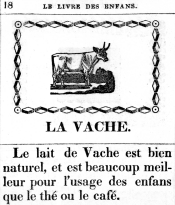




















|
|

Before one can use books, one has to learn to read. Most of the children's literature available to early Canadians was designed to moralize or instruct. Readers and other textbooks were crucial to the development of Canadian society. Before the 1850s, education was a private matter with the Church playing a major role. Textbooks were either imported, reprinted locally, or written by educators teaching in large religious institutions - certainly a captive market. During the second half of the 19th century, with the establishment of a public school system of education, the curriculum was standardized, teachers received training, and schooling, supported by taxation, became compulsory. The great demand for standardized textbooks across the country brought about the reprinting of series of schoolbooks from Ireland and Scotland. Large Canadian publishers such as John Lovell and James Campbell also published their own series. By the end of the century, Canadian educators were writing their own readers, grammars and other school texts.

The first successful children's magazine in Canada.
|

|
The Snow Drop; or, Juvenile Magazine. 1847-1853.
Montreal: Lovell and Gibson; Toronto: Scobie and Balfour, and others. |

This primer was printed for Daniel Claus (1727-1787), deputy superintendent of Indians in Canada. A first edition had been printed at Fleury Mesplet's shop in Montreal in 1781. It was much used by the Loyalist Mohawks to study their own language, as well as English. The frontispiece, engraved by James Peachey, represents a class of Native schoolchildren receiving instruction.
|

|
A Primer for the Use of the Mohawk Children... / Waerighwaghsawe Iksaongoenwa....
London, England: Printed by C. Buckton, 1786. 98 p. |


|
Le Livre des enfans.
Québec: Thomas Cary et Cie., 1834. 24 p.
|

This German speller and reader was the sixth edition, stereotyped in Philadelphia. The plates were probably sent to Berlin (Ontario) and other German settlements to be printed.
|

|
Jakob Teuscher
ABC Buchstabir - und Lesebüchlein, mit Rücksicht auf die Lautirmethode....
[ABC: Speller and reader: also touching on pronunciation... ].
Berlin, C[anada] W[est] [Kitchener, Ont.]: Bödecker und Stübing, 1863. 45 p.
|

A first book for learning to write Yiddish. Figler also published other books to learn to write Hebrew.
|
I. Figler
Figler's Jewish Writing Method.
Montreal: I. Figler, [circa 1917]. |


|
Little Folks Alphabet.
Toronto: Canada Games Co., [©1919]. [10] p.
|

Maxine [pseudonym of Marie-Caroline-Alexandra Bouchette, 1874-1957]
ABC des petits canadiens... illustrations de J.-Arthur Lemay.
Montréal: Éditions A. Lévesque, 1933. 31 p.
|

|
